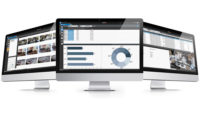When it comes to the biggest challenges, opportunities and technology trends in the security industry, the Securing New Ground conference (SNG), held in person October 18-19 in New York City for the first time after two years of going virtual due to COVID-19, hit the ground running with all the important conversations. SNG, held annually for over 25 years, is the Security Industry Association’s premier executive conference, which brings together top business leaders from financial heavyweights to CEOs of large corporations, along with security dealers and integrators to discuss the most pressing issues in the industry.
This year those conversations included supply chain issues, the economy, cybersecurity, AI, proptech and more.
After a morning of sessions including an industry overview, and a much talked about discussion on security as proptech (including findings from the SIA Proptech Report on how property managers and owners invest in and use security solutions), the action turned to some of the major pain points facing security integrators today.
Moderated by Stephanie Mayes, vice president of sales, SiteOwl, the session, “Systems Integration Business Conditions” brought together Dee Ann Harn, CEO and president of RFI Enterprises, Jim Lantrip, senior vice president operations, Allied Universal Technology Services and John Palumbo, CEO of Unlimited Technology for a panel discussion that started right off the bat with the issue of workforce development and talent acquisition.
“We talked long and hard about the industry and how we are a little bit stagnant in finding new young talent,” Lantrip said. “We are taking a focused approach to find new, young talent, whether that is tech schools, military or even some high school programs.”
Both Harn and Palumbo touched on the importance of hiring or appointing a key person whose sole job is recruitment. “It is key and a game changer for us,” Palumbo said.
The conversation then moved to supply chain problems, something that would be touched on several times over the two-day conference.
“It’s been such a weird year,” Harn said. “Everything collided at the same time. Things that were true a few years ago aren’t now. Everything has gone up and you have to adjust your costs. Figure out what you can control and deal with that. Know your job, trust your gut and get it done,” she advised.
From challenges, the next session switched to technology opportunities in “Taking Artificial Intelligence Out of the Lab,” featuring Dean Drako, founder and CEO of Eagle Eye Networks, Azizur Rahman, senior vice president, AlertEnterprise, Phillipe Sawaya, director of artificial intelligence, ADT Commercial, and Jason Veiock, senior director, safety security and resilience, GoDaddy.
This high-level discussion went deep into how AI is being used and what it’s future is in security — with panelists sometimes disagreeing with one another — but there was consensus on the importance of this technology and that it will absolutely increase in value to security applications.
Veiock cautioned not to silo data into security an non-security data. “Physical security data is just data. The minute we start thinking about it in a silo we put it in a box. There is so much data available for basic security functions that we aren’t using.”
Drako noted that some of these functions aren’t used because they aren’t being presented commercially and have traditionally been too expensive for most applications, but that is starting to change. He added that the real value for integrators will come when they can realize the opportunity to utilize AI beyond just security.
“I believe that AI will become core to the industry both for video and access control, Drako said. “AI excels when there is a large amount of data. … Safety and security cases are somewhat tightly defined. There are only so many things in that world we are going to do. But … there is an opportunity to expand beyond security into the core business processes of all these companies. Integrators have this opportunity to bring AI into this and deliver more than security. It makes the market 10 times larger.”
Speaking with SDM later, Drako explained that he believes AI will fundamentally change the video industry. “Cameras will be used to enhance business efficiency, safety and security. Safety will be a higher priority than it has ever been. Business efficiency will be the new thing that gets added to the mix: solving business problems. It is a bigger opportunity than people realize.”
One of the heaviest topics of the day was the session on “Cybersecurity Threats and Leading in a World of Converged Security.” Often a tough topic to digest, this session aimed to make it more relatable with panelists from Allied Universal, Allegion, and Otis Elevator, and was moderated by John Deskurakis, chief product security officer for Carrier.
Deskurakis talked about the problem of “white noise” when it comes to discussing cyber in the physical security space. “When you are conducting day-to-day operations and cyber folks like us come in and give you a bunch of information it doesn’t have the context for you,” he said.
Rachelle Loyear, vice president, integrated security solutions, Allied Universal Technology Services, provided some real-world security experience with this issue.
“How can cyber leaders share information with physical leaders that relate to their space? I like this question a lot,” she said. “I don’t care what kind of risk it is; it is a risk to enterprise. What really matters is there is a risk and if you can boil the language down so you don’t have to talk about the specific kind of intrusion you can agree on the commonality of purpose.”
With trends such as the earlier AI discussion fresh in their minds, these panelists all agreed that while more data is helpful to security practitioners who can use it for business purposes, it also poses greater cyber risks.
“When I think about more data I think about more problems,” said Justin Scheitlin, chief information security officer for Allegion. “The more we consume and the more we build into a single place, now we have a bunch of information that becomes an attack vector.”
Just as the AI panel discussed the need to do away with silos, that was Loyear’s conclusion for cybersecurity as well. While acknowledging that as an integrator she is on the front lines and the “last mile” to understand what is at stake when it comes to cybersecurity and install it using cyber hygiene, she added, “People need to get it together. All of those stakeholders have a piece of this. We want to keep it in our little silos to make sure our little bit of it is safe, but that is not how connected worlds are going to function. All of us are going to be exposed to these things. If we are all on board with this together and all responsible, that is going to allow everybody to come to the table and we won’t need to worry about whose title is what. We have got to bring this into one big picture.”
Day one ended with an engaging panel bringing together some of the biggest end user names out there, including Meta (Facebook), Amazon and Major League Soccer, for a discussion on what they are looking for in security.
Heather Warner, head of global physical security operations technology for Amazon, noted the importance of technologies such as AI for companies like hers. “For us there is so much data we have to leverage AI to glean information.”
However, she cautioned security providers in the room that she isn’t looking for more products. “Please don’t come to me with your product. What we have found happens a lot is we end up with a lot of things, a lot of applications and different ways to slice a bigger problem. I am looking to not do that. I want to make it very, very easy for our users to get exactly what they want by going to fewer places.”
Day two featured some of the major highlights of the conference, all touching on the biggest unknowns and fears right now: the economy and supply chain.
This year’s conference featured a keynote from Phil Mackintosh, the chief economist for NASDAQ, on the economic outlook for the coming year. Noting that this has been a tough year for investors due to COVID-induced inflation, a stimulus plan he compared to a “sugar high” and the impact of supply chain shortages and the war in Ukraine, much of his presentation was not overly positive — or surprising to attendees.
But there was hope among the less than positive outlook. “If you talk to CEOs today they are pretty negative,” he said. “If you are in manufacturing or services you feel like business has been contracted for months. CEOs tend to be kind of optimistic, so that is not a great reading. If you are running a company you are coming off a sugar high. The stimulus made things a little too easy. Then the supply chain slowed things down.”
He noted that leading indicators show that the supply chain is normalizing, including gas prices and car prices both coming down. But that is tempered by the services side (wages, rents, etc.) which are harder to get to come back down once they goes up. However, he said rents are expected to fall soon and there are a lot of signals that inflation is coming down. So while most expectations are that there will be a recession it may not be all that bad.
“Recessions aren’t always as bad as ones in recent memory,” he said. “Most are much less impactful. Given all this, where we are now really doesn’t look that bad. The message I want to leave is we may have a recession but it should be softer than we are used to seeing. It really depends on whether the Fed is listening to the data. If it does start to slow and inflation comes down the Fed can take their foot off the gas.”
From there it was back to supply chain with the session “Unraveling the Supply Chain of Security,” moderated by Mark Hillenburg, vice president, industry relations for DMP and featuring panelists Trevor Stewart, president and CEO of Security Control Integrators, John Sullivan, senior vice president of strategic accounts for ADI and Nick Stoner, vice president of PACS North America channel sales for HID Global.
This much-anticipated panel echoed some of the frustrations of earlier panelists, but also gave attendees some hope to leave with, as well as some insight on the longer-term impacts the supply chain crisis will have on the industry.
Stewart summed up his overall attitude to the issue as “frustrated,” something probably all the attendees in the room could relate to. “As an integrator we are on the front lines. We are between forest fires and house fires with manufacturing and distribution. Our bread and butter is the $50,000-$100,000 job running 60-90 days. Now we have several jobs running over 12 months. … The problem I see is I feel like it is getting better, but we don’t have everything we need to finish a project. We used to consider ourselves a specialty niche integrator — Tiffany’s as opposed to K-Mart — but we can no longer design to the best solution but now have to design to the best available solution based on supply line. We are handcuffed. We know they are out there and we want to provide them, but we have to tell our customers quite frankly, ‘This is the solution this year and this is a better solution, but can you wait until next year?’”
Hillenburg also discussed feeling handcuffed on the manufacturing side, but in a different way. “Where we feel handcuffed is on the new innovation front. New designs suffer because our engineers are working overtime to re-engineer current products for supply. As an industry we may see a lack of new innovations in the next couple years that ties back to this.”
HID’s Stoner also mentioned the need to spend money and resources on re-engineering, but offered a ray of hope for those waiting on product from his company, which he acknowledged was one of the harder hit in the industry.
“What has been interesting from the semiconductor perspective is that we weren’t the only ones redesigning products. All of that work by us and others in the space is freeing up some choke points that were there and we are seeing more commitments from semiconductor manufacturers.
“The other thing working right now is customers wanted dates from us. In a lot of cases earlier we didn’t have them because we were seeing decommits in our supply chain. We didn’t have that information. As we start to see the supply improve from components we are undertaking major initiatives to provide dates farther in advance. You may not have seen it yet, but it is coming in the next few months.”
While all agreed they are seeing some improvement, it will take some time to resolve. From an integrator perspective, Stewart added that this experience has changed their approach in more ways than just having to have tough discussions with customers.
“In our business we kind of went back to basics. We got comfortable with a couple of manufacturers that worked well. We never thought we wouldn’t be able to get them. As an integrator we now know we have to have alternate products. We are the face of the manufacturer and distributor. We have to believe in this chain. But we have to expand the chain … We want to keep consistency and make sure our customers are secure. But we need to educate ourselves and not get comfortable again.”
The last session at SNG featured the traditional look at the M&A markets.
John E. Mack III, executive vice president and co-head of investment banking group and head of mergers and acquisitions for Imperial Capital noted that the capital markets have seen a significant decline in the last year because of overstimulation, but valuations have held up so far.
Alper Cetingok, managing director, group head, diversified industrials for Raymond James, described the recent period as historically high, very prolific but not sustainable. “Strategic acquirers have made a comeback but in general private equity is down. 2021 is probably a year that will never be replicated.”
Still, he added that the security industry is generally recession resistant and will likely not be impacted as much.
Finally, Robert Chefitz, managing general partner for Egis Capital Partners, tied many of the themes of the conference together by noting that overall the security industry is in a good position.
“Proptech, AI and IoT have a attracted a lot of money — and our industry sits right in the middle of these global innovations.”






